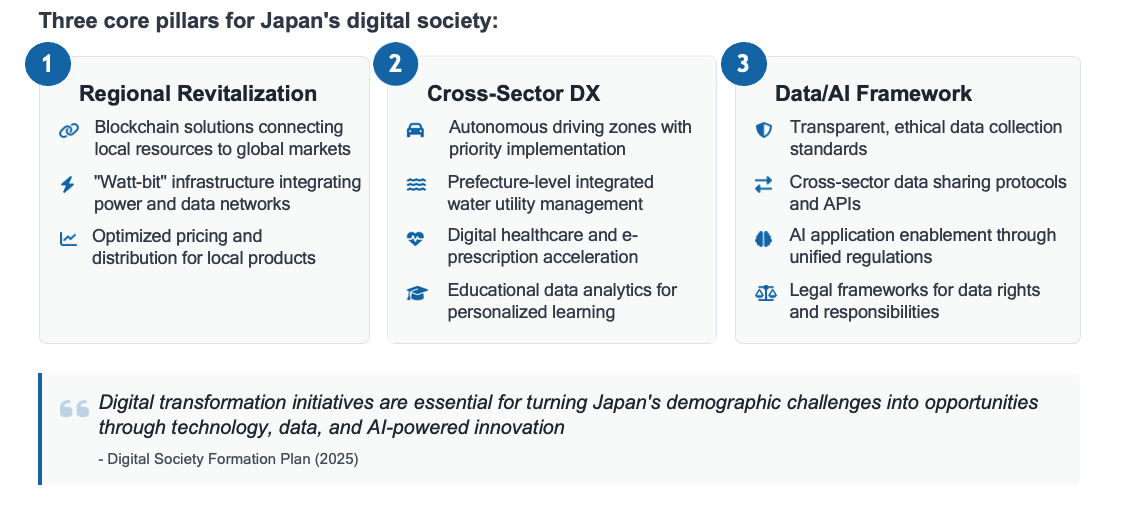Navigating Japan's New Policy Landscape: Key Insights from the June 13, 2025 Cabinet Decisions
On June 13, 2025, the Japanese government made a series of coordinated announcements that sets the path for policymakers for the coming years. Six major policy packages were approved on the 13th; paving the way for a unified approach to Japan's most pressing challenges.
The Big Picture: A Coordinated Policy Revolution
These six packages combine into a comprehensive framework that is designed to address Japan's demographic challenges, economic transformation needs, and global competitiveness imperatives in a coordinated manner. The interlinkages between these various policy documents indicate the government’s holistic view of how to chart the course for Japan’s future.
The core framework consists of four pillars:
Basic Policies for Economic & Fiscal Management (or the Honebuto no Houshin) 2025: the macro framework setting Japan's growth trajectory;
New Capitalism Grand Design & Implementation Plan: the operational blueprint for sustainable growth;
Regional Revitalization 2.0 Basic Policy: the territorial strategy for balanced development; and
Regulatory Reform Implementation Plan: the institutional foundation enabling transformation
Economic Ambitions: The 1,000 Trillion Yen Vision
Perhaps the most striking element of the new policy framework is Japan's bold economic ambition. The government has set a target of achieving nominal GDP of 1,000 trillion yen by approximately 2040. This is a significant leap from current levels that would require sustained annual growth and productivity improvements.
To achieve this, the government has established a new social norm: real wage increases of 1% annually through 2029. This isn't merely an aspiration but a coordinated effort involving government procurement policies, minimum wage strategies, and comprehensive support for small and medium enterprises (SMEs) that employ 70% of Japan's workforce.
For businesses and stakeholders, this signals a fundamental shift in Japan's economic model: from deflationary pressures to growth-oriented policies that prioritize wage increases as a driver of economic expansion.
Regional Strategy: Beyond Tokyo-Centric Development
The Regional Revitalization 2.0 initiative represents perhaps the most ambitious territorial development strategy Japan has undertaken since the post-war reconstruction. Rather than continuing the centralization trend, the government is actively promoting what officials call "Reiwa-era national land transformation."
The strategy rests on five key pillars:
Creating appealing rural living and working environments;
Building value-added local economies through innovation;
Facilitating population and business decentralization;
Deploying AI and digital infrastructure as regional equalizers; and
Establishing cross-prefectural collaboration frameworks
For companies considering expansion or relocation, this policy framework suggests significant incentives and support mechanisms will be available for operations outside major metropolitan areas.
Digital Transformation: The Infrastructure of the Future
Japan's digital transformation (DX) strategy goes beyond typical DX initiatives. The government is positioning digital infrastructure as the foundation for addressing labor shortages, regional disparities, and industrial competitiveness simultaneously.
Three focal areas are particularly relevant for stakeholders:
Regional digital solutions: using blockchain and advanced technologies to connect local resources directly with global markets;
Sector-specific deregulation: accelerating autonomous systems in construction, transportation, and healthcare; and
Data governance frameworks: establishing legal foundations for AI development and data utilization
With jurisdictions around the world, including even the typically more heavy-handed EU, taking a softer approach to regulations surrounding AI, Japan has the opportunity to truly revolutionize its digital transformation as we head into the 21st century.
Regulatory Reform: Enabling Innovation
The regulatory reform agenda is specifically designed to support the other policy pillars. Key areas include flexible work arrangements for startups, updated safety regulations for autonomous machinery, and comprehensive mobility reforms including ride-sharing and autonomous vehicles.
For businesses in regulated sectors, this signals an opportunity to engage early in rule-making processes as the government seeks to balance innovation with safety and social objectives. Engaging at all levels, both on the bureaucratic and political spectrums, will be critical to ensuring a consistent message to policy makers.
Implementation Timeline: Windows of Opportunity
Understanding the policy formation cycle is crucial for effective engagement. The government follows a predictable annual rhythm:
June: Strategic direction setting (as demonstrated this year)
July-August: Detailed planning and budget preparation
September-December: Inter-ministerial coordination and finalization of the budget
January-April: Legislative introduction of budget and implementation
This creates specific windows for stakeholder engagement; particularly during the detailed planning phase in late summer and early fall. The Upper House election in July does alter this a bit, with politicians and their offices busy with getting their colleagues elected, but this also provides opportunities for renewed relationship building post-election.
Strategic Implications for Stakeholders
The coordinated nature of these policies creates both opportunities and challenges:
Opportunities
Early movers in regional markets may benefit from substantial government support
Companies aligning with wage increase objectives may find favorable policy treatment
Digital transformation initiatives will likely receive regulatory fast-tracking
Cross-sectoral collaboration may unlock new business models
Challenges
Implementation capacity constraints, particularly at local government levels
Balancing fiscal expansion with debt sustainability concerns
Coordinating complex regulatory changes across multiple sectors
Managing international competitiveness while pursuing domestic objectives
Conclusion
The June 13, 2025, cabinet decisions represent more than policy updates: they constitute a fundamental reorientation of Japan's development strategy. For government relations professionals, success will depend on understanding not just individual policies, but how they integrate into a comprehensive vision for Japan's future.
The key takeaway is that this is not business as usual. The coordinated timing, ambitious targets, and systematic approach suggest a government committed to substantial change. Organizations that position themselves as partners in this transformation, rather than passive recipients of policy changes, will be best positioned for success in Japan's evolving landscape.
For more regular updates like this on Japanese politics and public policy, please sign up to our mailing list.
This analysis is based on official government documents and public statements from the June 13, 2025 cabinet decisions. Policy details continue to evolve as implementation guidelines are developed.




